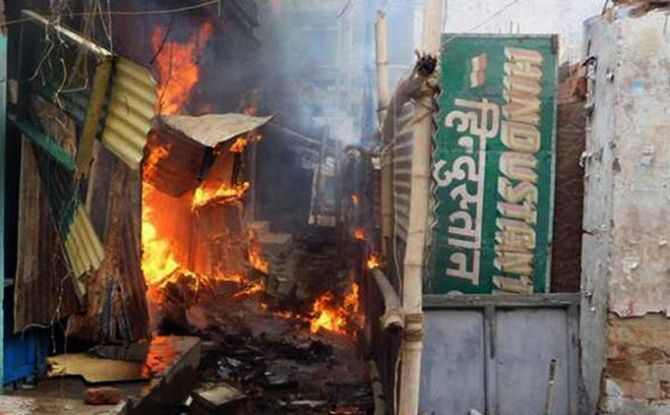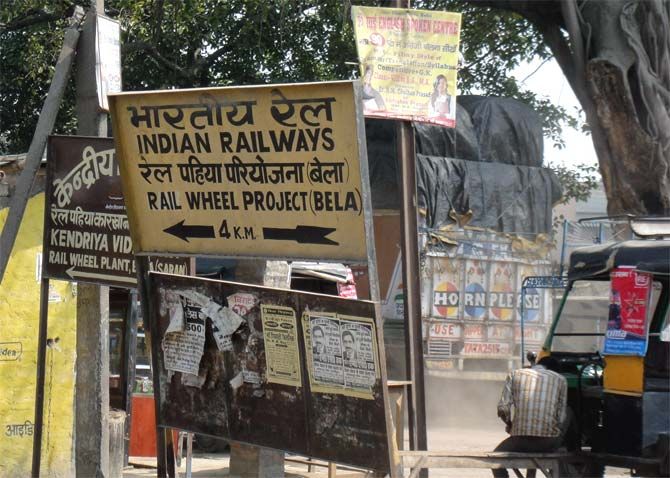
'Consider this image of today's youth in Bihar -- armed with a bike, a smartphone and possibly some illegal arms too, imbibing incessant stream of images from the Internet and television.'
'Some of them would turn into gau bhakts, some would listen with interest the exploits of Salafism, dig deep into the Internet to come out with images which cry vociferously that their respective religions are in danger,' says Mohammad Sajjad.
On the afternoon of August 5, reports started coming in that Bajrang Dal activists had looted and burnt shops owned by Muslims in Chhapra, the district headquarters of Saran in north Bihar. One of the shops was owned by Balaghul Mobin of the Rashtriya Janata Dal, a part of the dominant ruling alliance in the state.
When the local police was unable to control the violence, the state administration brought in its more competent and credible officer, Kundan Krishnan.
The immediate provocation for the communal violence was this: A young Muslim, Mohammed Mubarak, of village Maker (20 km north of Chhapra, and bordering on the Saraiya thana area of Muzaffarpur), allegedly circulated an objectionable video on WhatsApp.
Though Mubarak was eventually arrested by the police from Kalyan in Maharashtra, the local police delayed taking action against him on August 5 even after villagers informed them about the video.
The allegations of police complicity with the rioters in Chhapra are based on the fact that when Muslim-owned shops were being looted and burnt, the police remained a mute spectator.
The police station is less than 50 metres away from where the violence took place. There were reports that Bajrang Dal activists came out on the streets and announced a bandh in the town. Police vehicles were damaged and Krishnan was attacked. Following which the Indo-Tibetan Border Police and Rapid Action Force were deployed.

Saran district has been known for Yadav electoral dominance even before Lalu Yadav emerged as a political hegemon in 1990. The late Ram Jaipal Singh Yadav used to be a minister in the early 1970s and was elected several times from Sonepur in the 1960s and 1970s.
Another Yadav, Darogha Rai, was Bihar's chief minister (February to December 1970). His son Chandrika Yadav represents Parsa, one of the Saran assembly seats. This dominance is aptly reflected in naming of the long bridge on the Rewa Ghat of the Gandak after Darogha Rai.
Since Independence, Muslims in the assembly segments of Saran district used to be mere voters with almost no assertion for political power. Till 1946, the Muslims of Chhapra town had considerable presence in education, employment and trade.
In recent times, Salim Parvez has emerged as an important Janata Dal-United leader in the district and was pitted against Rabri Devi in the Lok Sabha elections of 2014.
The Saran division (comprising the districts of Saran, Siwan, and Gopalganj) borders Deoria district in Uttar Pradesh. The Bajrang Dal's current chief, Rajesh Pandey, belongs to Deoria. Pandey was earlier the media manager for Atal Bihari Vajpayee in Lucknow during the elections.

In the midst of the competitive communalism of the 1980s (Shah Bano versus Ram Janambhoomi) and the emergence of the gangster-legislator Mohammed Shahabuddin in the 1990s, came the rise of Lalu Yadav in the 1990s. The last two developments escalated the aspiration levels of a section of Muslim youth.
The story is not much different with other social groups. Munna Shukla has his sway across Muzaffarpur and Vaishali, and he is a role model of sorts for a section of Bhumihar youth.
The same goes with Suraj Bhan and Anant Singh in the Mokama-Barh belt of central Bihar. Anand Mohan Singh is similarly lionised by Rajput youth. Pappu Yadav is another icon for the youth of his community.
That is how the people of Bihar and eastern UP have been living under the shadows of gangsters-cum-legislators-cum caste heroes for many decades.
The process of the criminal turned caste/community hero attained greater salience in the 1980s. An astute observer of Bihar, Arvind N Das (1948 to 2000) had this to say in his seminal The Republic of Bihar:
'The state has been carved out into zones of influence of local 'leaders,' mostly with daunting criminal records. Many of them are MLAs; some are ministers. From Mohammed Sulaiman's territory in Kishanganj through Pappu Yadav's domain in Purnea-Madhepura, one can cross Bihar by passing through Anand Mohan Singh's area and then into the realm of Raghunath Pandey (Muzaffarpur), and 'Samrat' Ashok and further into the Gopalganj belt of Salaluddin and the wild west of Champaran. Alternatively, one can go through, Makhi Paswan's Khagaria, Kailu Yadav's region, into the Dularchand tal and then through Dilip Singh's land and on to the lawless Kaimur ranges crossing the realm of Surendra Yadav.'

As an insider, I have observed that at the local level, these ambitious, criminally oriented youth of various castes and communities operate as syndicates and cooperatives, and as suppliers and traffickers of illegal arms.
They are frequent visitors to the police thanas and block development offices. They act as fixers and brokers in such establishments. No state functionary knows them better than the local police and the deputy collectors of the Bihar administrative services serving as BDOs.
Even then the higher state functionaries in the police and the administration either remain woefully ignorant (or feign to be so) about these characters. Their crimes often remain unreported. These characters also act as huge resource persons for the bigger gangsters turned legislators. They act as informers and as henchmen, besides indulging in vehicle-snatching and kidnapping for ransom.
The investigative media and the police should look more closely at the instance if Bihar and its society really want to prepare an effective mechanism of combating this deadly cocktail of crime and communalism, all for political gains.
The police and media need to similarly expose the social base of the Bajrang Dal as to which kind of unemployed youth form the backbone of such organisations. In the case of Saran, there are some indications that new rural elites, specifically Yadavs, have joined the Bajrang Dal in good numbers.
It is clear from the police version that Mubarak had criminal antecedents and he was operating as part a group and not as a solo performer. The hand that seems to have guided Mubarak ought to be identified.
A friend who served in the rural administration in Bihar commented on the Saran violence in the following words:
"What bothers me is the utter lumpenisation of the grassroots. A riot or communal tension here or a caste wrangle there could well be the result of failed political ambitions at the level of the panchayat elections," the friend said.
"Their desirability apart, they invariably manage to churn elemental passions which float in the atmosphere after the elections are over," he added.
"Add to this a disturbingly typical image of today's youth in Bihar -- armed with a bike, a smartphone and possibly some illegal arms too, most probably unemployed or semi-employed, imbibing incessant stream of images from the Internet and television, at the edge of the urban economy, averse to do what his parents are unable to find/provide -- a job in the metropolis that could support this daydreams; he would remain split between his desired self-image and his run-down existence."
"This split would find manifestations in his attempts to contrive a meaning for his largely meaningless life. Some of them would turn into gau bhakts, some would listen with interest the exploits of Salafism, dig deep into the subterrannean recesses of the Internet to come out with images which cry vociferously that their respective religions are in danger."
"They decide that some excitement is long overdue. The rest is done by the Internet. Mayhem, murder massacre follow.'

Bihar society is undergoing a disturbing flux. These hoodlums, on being elected to panchayats, make money and have luxury houses in the towns, without the scanner of the income tax department.
Some others would raise funds for constructing/renovating masjids and mandirs and in order to assert their respective identities they will go for the tallest possible minars, and the costliest possible marble in the masjids, besides eventually becoming Hajis.
Quite often they are the brick manufacturers as well. This is how these panchayat functionaries raise money, as they would frankly admit, to purchase, symbols of winning political parties at the time of assembly elections, and eventually aspiring to enter Parliament.
Saran does not have any noticeable industries nor does it have rich agriculture, as no effective irrigation system has there been in place despite the Gandak river. Lalu Yadav's promise of a rail coach factory is a recent development, growing into a reality, rather too reluctantly.
Maker is close to the historic village of Vaishali which is yet to figure on the rail map despite its promises of a tourism economy. The low-lying water logged lands (chaur) offer little hope for farmers.
The Hindu upper caste landed elites (more particularly the Rajputs and the Bhumihars) secured public employment by opening up degree colleges in the early decades of Independence, which were subsequently taken over by the government.
The district may have poor literacy, but even its rural areas have many government degree colleges, including one at Amnour, the ancestral village of Rajiv Pratap Rudy, close to the village of Maker.
Rudy, the Union minister for skill development, is Chhapra's incumbent MP.
While assessing his ministry's accomplishments would be too early, it can perhaps be metaphorically said that sections of people from his constituency have been developing the skills of crime and violence.
The MP has preferred to remain silent on the latest violence in his constituency.

Highly placed officers, overburdened with administrative tasks, may not have much time to look into the history of the region they serve. Probably because of this, Kundan Krishnan, said that Saran is known for communal harmony.
One of the first major communal riots was the Basantpur, Siwan, riots of 1893. Anand A Yang, who has studied Saran's history, demonstrates how the cow vigilantes, using the communication networks of the people's gatherings of weekly markets (haats) mobilised the majority community to chastise putative beef eaters. Large scale killings were carried out in Basantpur.
Again, in October 1946, Saran found itself in the fire of communal violence on a very big scale, when 'anti-Noakhali Day' was observed on October 25, 1946. Incidentally, the violence on August 6, 2016 started from the same Karimchak mohalla of Chhapra, from where the October 1946 riots had started.
In my book Contesting Colonialism and Separatism (2014), I have cited evidence to narrate how villages after villages of Saran (such as Khodaibagh, Rasulpur, Jalalpur, Olhanpur, Nagra, Katendar, Paighambarpur) had to be vacated by the Muslims. Even the then collector of Chhapra was accused of having abetted the riots, along leaders of the local Congress and of the Muslim League on different sides.
After Independence, in some of these villages, graves of the victims came to be declared as 'worshippable' ones. Hindus of these villages still continue to revere some such Muslim graves. Is it because of the contrition and remorse about the 'collective guilt' committed in 1946? This is a question awaiting academic exploration in rural Saran suggests a friend who taught political science in a Chhapra college.
Subsequent to the October 1946 riots, when Mahatma Gandhi visited the affected areas in March 1947, Pyarelal, in his Mahatma Gandhi: The Last Phase, reports that many Congressmen came and confessed before Gandhi their involvement in the killings. But that was Gandhi.
We now live in an age when adoring Nathuram Godse, Gandhi's murderer, is becoming the dominant political ideology.

If we wish to ensure sustainable peace, the criminal justice system needs to become much effective. Sadly, this is an aspect on which Indian democracy has almost wilfully failed quite miserably.
Even the Lalu-Rabri regime (1990 to 2005), which earns so many laurels on the count of having controlled communal riots rather firmly was found equally disappointing in terms of bringing the rioters of Bhagalpur (1989), Sitamarhi-Riga (1992) to book.
Besides, the economic factors of growing social tension need to be addressed. This deadly cocktail of crime and communalisation needs serious comprehensive attention. A massive police crackdown on the mohalla hoodlums is the urgent need.
In the recent riots in Saran and Tirhut, there is a pattern wherein the immediate flashpoint has been some misdeeds of the hoodlums provoking communal violence wherein the hoodlums have resorted to looting and arson, arriving in large numbers on motorbikes which demonstrate that these riots have been pre-planned.
Yet, the local police and intelligence claimed to have been caught unawares. These hoodlums have been reported to be getting political patronage. This possibility may not be ruled out even in the case of the recent Saran violence as well.
Mohammad Sajjad is Associate Professor, Centre of Advanced Study in History, Aligarh Muslim University.











 © 2025
© 2025